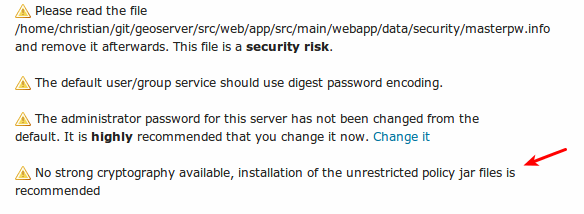Java Considerations¶
Use Supported JRE¶
GeoServer’s speed depends a lot on the chosen Java Runtime Environment (JRE). For best performance, use Oracle JRE 7 (also known as JRE 1.7). JREs other than those tested may work correctly, but are generally not recommended. As an example users of OpenJDK 1.6 report GeoServer 2.5 to be working with reduced 2D rendering performance.
Tested:
- Java 7 - GeoServer 2.6.x and above (OpenJDK and Oracle JRE tested)
- Java 6 - GeoServer 2.3.x to GeoServer 2.5.x (Oracle JRE tested)
- Java 5 - GeoServer 2.2.x and earlier (Sun JRE tested)
Unsupported:
- Java 8 - unsupported with known issues (does not currently build)
As of GeoServer 2.0, a Java Runtime Environment (JRE) is sufficient to run GeoServer. GeoServer no longer requires a Java Development Kit (JDK).
Install native JAI and JAI Image I/O extensions¶
The Java Advanced Imaging API (JAI) is an advanced image manipulation library built by Oracle. GeoServer requires JAI to work with coverages and leverages it for WMS output generation. By default, GeoServer ships with the pure Java version of JAI, but for best performance, install the native JAI version in your JDK/JRE.
In particular, installing the native JAI is important for all raster processing, which is used heavily in both WMS and WCS to rescale, cut and reproject rasters. Installing the native JAI is also important for all raster reading and writing, which affects both WMS and WCS. Finally, native JAI is very useful even if there is no raster data involved, as WMS output encoding requires writing PNG/GIF/JPEG images, which are themselves rasters.
Native extensions are available for Windows, Linux and Solaris (32 and 64 bit systems). They are, however, not available for OS X.
Note
These installers are limited to allow adding native extensions to just one version of the JDK/JRE on your system. If native extensions are needed on multiple versions, manually unpacking the extensions will be necessary. See the section on Installing native JAI manually.
Note
These installers are also only able to apply the extensions to the currently used JDK/JRE. If native extensions are needed on a different JDK/JRE than that which is currently used, it will be necessary to uninstall the current one first, then run the setup program against the remaining JDK/JRE.
Installing native JAI on Windows¶
- Go to the JAI download page and download the Windows installer for version 1.1.3. At the time of writing only the 32 bit version of the installer is available, so if you are using a JDK, you will want to download jai-1_1_3-lib-windows-i586-jdk.exe, and if you are using a JRE, you will want to download jai-1_1_3-lib-windows-i586-jre.exe.
- Run the installer and point it to the JDK/JRE install that GeoServer will use to run.
- Go to the JAI Image I/O download page and download the Windows installer for version 1.1. At the time of writing only the 32 bit version of the installer is available, so if you are using a JDK, you will want to download jai_imageio-1_1-lib-windows-i586-jdk.exe, and if you are using a JRE, you will want to download jai_imageio-1_1-lib-windows-i586-jre.exe
- Run the installer and point it to the JDK/JRE install that GeoServer will use to run.
Installing native JAI on Linux¶
Go to the JAI download page and download the Linux installer for version 1.1.3, choosing the appropriate architecture:
- i586 for the 32 bit systems
- amd64 for the 64 bit ones (even if using Intel processors)
Copy the file into the directory containing the JDK/JRE and then run it. For example, on an Ubuntu 32 bit system:
$ sudo cp jai-1_1_3-lib-linux-i586-jdk.bin /usr/lib/jvm/java-6-sun $ cd /usr/lib/jvm/java-6-sun $ sudo sh jai-1_1_3-lib-linux-i586-jdk.bin # accept license $ sudo rm jai-1_1_3-lib-linux-i586-jdk.bin
Go to the JAI Image I/O download page and download the Linux installer for version 1.1, choosing the appropriate architecture:
- i586 for the 32 bit systems
- amd64 for the 64 bit ones (even if using Intel processors)
Copy the file into the directory containing the JDK/JRE and then run it. If you encounter difficulties, you may need to export the environment variable
_POSIX2_VERSION=199209. For example, on a Ubuntu 32 bit Linux system:$ sudo cp jai_imageio-1_1-lib-linux-i586-jdk.bin /usr/lib/jvm/java-6-sun $ cd /usr/lib/jvm/java-6-sun $ sudo su $ export _POSIX2_VERSION=199209 $ sh jai_imageio-1_1-lib-linux-i586-jdk.bin # accept license $ rm ./jai_imageio-1_1-lib-linux-i586-jdk.bin $ exit
Installing native JAI manually¶
You can install the native JAI manually if you encounter problems using the above installers, or if you wish to install the native JAI for more than one JDK/JRE.
Please refer to the GeoTools page on JAI installation for details.
GeoServer cleanup¶
Once the installation is complete, you may optionally remove the original JAI files from the GeoServer instance:
jai_core-x.y.z.jar
jai_imageio-x.y.jar
jai_codec-x.y.z.jar
where x, y, and z refer to specific version numbers.
Installing Unlimited Strength Jurisdiction Policy Files¶
These policy files are needed for unlimited cryptography. As an example, Java does not support AES with a key length of 256 bit. Installing the policy files removes these restrictions.
Open JDK¶
Since Open JDK is Open Source, the policy files are already installed.
Oracle Java¶
The policy files are available at
The download contains two files, local_policy.jar and US_export_policy.jar. The default versions of these two files are stored in JRE_HOME/lib/security. Replace these two files with the versions from the download.
Test if unlimited key length is available¶
Start or restart GeoServer and login as administrator. The annotated warning should have disappeared.

Additionally, the GeoServer log file should contain the following line:
"Strong cryptography is available"
Note
The replacement has to be done for each update of the Java runtime.
IBM Java¶
The policy files are available at
An IBM ID is needed to log in. The installation is identical to Oracle.